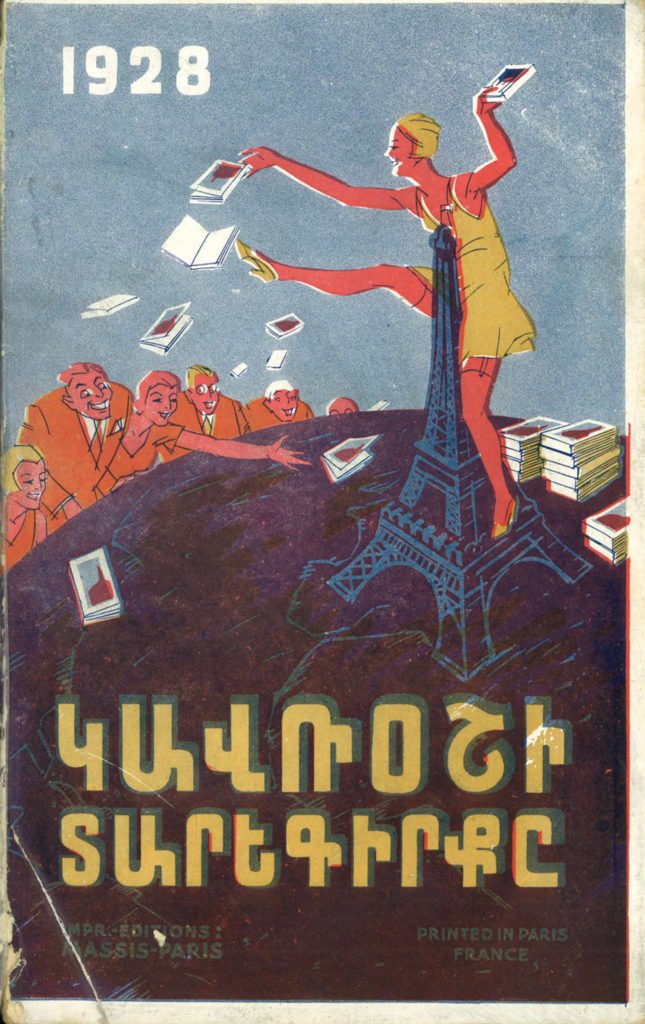BELMONT, Mass. — The National Association for Armenian Studies and Research (NAASR) has digitized and is making accessible through its online library catalogue a collection of more than 100 rare and fascinating taregirks (տարեգիրք) or “yearbooks” and taretsoyts (տարեցոյց) or “almanacs” from the holdings of its Mardigian Library. This project was undertaken through the generous support of the SJS Charitable Trust.
The collection of digitized volumes spans from the 1890s to the 1960s and includes titles published in Alexandria, Athens, Beirut, Boston, Constantinople, Paris, Tehran, Venice and elsewhere. NAASR has one of the most substantial collections of these extraordinary publications outside of university libraries, which are often not available to the public. NAASR selected these as priorities for digitization because they are a treasure trove of information, written to inform Armenians at the time about what was going on in various communities both politically and culturally. These yearbooks serve as important resources for any scholar or member of the public looking into a particular time and place in Armenian history.
The digitization began prior to the COVID pandemic by the late Berge Panosyan, who unfortunately passed away unexpectedly in 2021. The remainder of the job was completed in-house at NAASR by Ani Babaian, Nareg Kalaydjian, Marc Mamigonian and Miles Mamigonian.
 The terms “yearbook” and “almanac” do not fully convey the significance of these publications, which are vital sources of information on the affairs of particular communities and contain important literary and artistic works often not otherwise available elsewhere. Many of them are also strikingly designed and impressive visual works in their own right. For example, the still little-studied Gavrosh (Կավռօշ) yearbooks, published between 1906 and 1933 in Constantinople and Paris by Yervant Tolayan, was a feast for the eyes and specialized in humor. Navasard (Նաւասարդ), a Yearbook of Literary and Fine Arts published in Constantinople in 1914 and overseen by Daniel Varoujan and Hagop Siruni, is both beautiful and loaded with writings from some of the leading Armenian writers of the time and also contains translations into Armenian of works by Maurice Maeterlinck (1862-1949), Oscar Wilde (1854-1900) and Adam Mickiewicz (1798-1855). Many others are more prosaic in appearance but no less rich in information.
The terms “yearbook” and “almanac” do not fully convey the significance of these publications, which are vital sources of information on the affairs of particular communities and contain important literary and artistic works often not otherwise available elsewhere. Many of them are also strikingly designed and impressive visual works in their own right. For example, the still little-studied Gavrosh (Կավռօշ) yearbooks, published between 1906 and 1933 in Constantinople and Paris by Yervant Tolayan, was a feast for the eyes and specialized in humor. Navasard (Նաւասարդ), a Yearbook of Literary and Fine Arts published in Constantinople in 1914 and overseen by Daniel Varoujan and Hagop Siruni, is both beautiful and loaded with writings from some of the leading Armenian writers of the time and also contains translations into Armenian of works by Maurice Maeterlinck (1862-1949), Oscar Wilde (1854-1900) and Adam Mickiewicz (1798-1855). Many others are more prosaic in appearance but no less rich in information.

A wide range of Armenian communities are covered by these volumes, from pre-genocide Ottoman Armenians (Amenun Taretsoytsě, Hayun Taretsoytsě, Kikoi Taretsoytsě, Mer Taretsoytsě, and others), Armenian Americans (Amerikahay Taretsoytsě, Amerikahay Hanragitak Taregirk, Vtak Amerikahay Taretsoyts, and others), French Armenians (Parizahay Taretsoyts), Bulgarian Armenians (Vitosh-Ararat Pulkarahay Taregirk), Lebanese Armenians (Hamazgayini Taregirk, Amenun Taregirk), Egyptian Armenians (Egiptahay Taretsoytsě), and Persian Armenians (Parskahay Taretsoyts), among others.
While some of these publications and their value to researchers are well known, many remain obscure and little seen. It is hoped that by making them more widely accessible that greater light can be shed on the eras and locations that the volumes encapsulate. In addition, although some may be digitally accessible elsewhere online, the decision was made to include all since the collection housed within NAASR’s Mardigian Library has an integrity of its own. Additional titles and/or issues will be added as they are received, and upgrades will be done if better copies of individual items are added to the library.



Be the first to comment